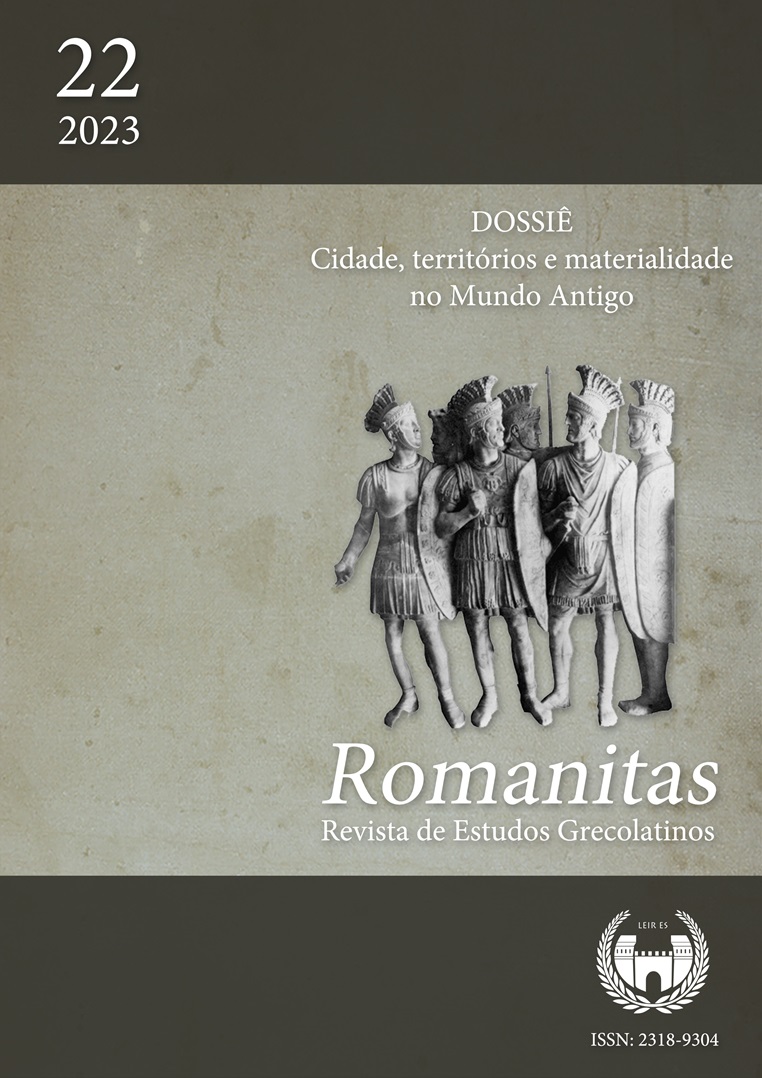Apresentação
DOI:
https://doi.org/10.29327/2345891.11.22-1Palavras-chave:
Apresentação, Romanitas, Cidade, Território, Espaço, MaterialidadeResumo
Inserido nas discussões apresentadas acima, o presente dossiê, intitulado “Cidade, território e materialidade no Mundo Antigo”, volta-se para as narrativas e usos dos espaços. Com o propósito de iluminar diferentes aspectos da materialidade no Mundo Antigo e na Antiguidade Tardia, apresentamos artigos e resenhas que abordam particularidades sobre as mais diversas cidades antigas, sob a perspectiva de historiadores e arqueólogos. Isso inclui questões de cunho historiográfico, cultural, político, religioso e social, sem perder de vista a importância da espacialidade na compreensão do cotidiano de indivíduos e grupos inseridos no modus vivendi das sociedades urbanas. Em face do exposto, este dossiê de Romanitas - Revista de Estudos Greco-latinos volta-se para uma tendência atual que combina concepções e métodos provenientes da História Urbana, da Arqueologia Clássica, da Geografia, da Arquitetura e da Sociologia, com o intuito de abordar de maneira plural e interdisciplinar esses ricos espaços que são as cidades, que de forma alguma devem ser pensados e tratados como estáticos e indeléveis.
Downloads
Referências
ALDROVANDI, C. E. V. Arqueologia do ambiente construído: uma incursão pelos fundamentos teórico-metodológicos. In: FLORENZANO, M. B.; HIRATA, E. F. (org.). Estudos sobre a cidade antiga. São Paulo: Edusp, 2009, p. 13-33.
BALANDIER, G. O dédalo: para finalizar o século XX. Rio de Janeiro: Bertrand Brasil, 1999.
BRAUDEL, F. Civilisation matérielle, économie et capitalisme (XVe et XVIIIe siècles). Paris: Armand Colin, 1967. t. 1.
CHILDE, V. G. The Urban Revolution. The Town Planning Review, v. 21, n. 1, p. 3-17, 1950.
COULANGES, F. La cité antique: étude sur le culte, le droit, les institutions, de la Grèce et de Rome. Paris: Durand, 1864.
CRIADO BOADO, F. Límites y posibilidades de la arqueología del paisaje. Spal – Revista de Prehistoria y Arqueologia, v. 2, p. 9-55, 1993.
FLORENZANO, M. B. Construindo o helenismo: o tirano e a monumentalização urbanística da pólis grega. In: ALDROVANDI, C. E. V.; KORMIKIARI, M. C. N.; HIRATA, E. F. V. (org.). Estudos sobre o espaço na Antiguidade. São Paulo: Edusp, 2011, p. 41-56.
GUARINELLO, N. L. Ordem, integração e fronteiras no Império Romano: um ensaio. Mare Nostrum, v. 1, n. 1, 113-127, 2010.
HARVEY, D. A produção capitalista do espaço. São Paulo: Annablume, 2005.
HODDER, I. Architecture and meaning: the example of Neolithic houses and tombs. In: PARKER PEARSON, M.; RICHARDS, C. Architecture and order: approaches to social space. London: Routledge, 1994, p. 73-86.
HODDER, I.; ORTON, C. Spatial analysis in Archaeology. New York: Cambridge University Press, 1976.
KORMIKIARI, M. C. N. et al. O estudo das fronteiras no Mundo Antigo: o caso grego. In: ALDROVANDI, C. E. V.; KORMIKIARI, M. C. N.; HIRATA, E. F. V. (org.). Estudos sobre o espaço na Antiguidade. São Paulo: Edusp, 2011, p. 125-155.
LE GOFF, P.; NORA, P. (dir.). Faire de l’histoire: nouveaux problèmes, nouvelles approches, nouveaux objets. Paris: Gallimard, 1974. 3 v.
LEFEBVRE, H. A revolução urbana. Belo Horizonte: Editora da UFMG, 1999.
LEFEBVRE, H. O direito à cidade. São Paulo: Centauro, 2008.
LÖW, M. O spatial turn: para uma sociologia do espaço. Tempo social, revista de Sociologia da USP, v. 25, n. 2, p. 17-34, 2013.
LYNCH, K. A imagem da cidade. Lisboa: Edições 70, 1982.
MARCUS, J.; SABLOFF, J. A. (ed.). The ancient city: new perspectives on urbanism in the old and new worlds. Santa Fe: School for Advanced Research, 2008.
MARTINS, M. M.; SILVA, G. V. Cidade antiga e sociedade: narrativas e diálogos interdisciplinares. In: FERREIRA, A.; MARQUES, A. (org.). As cidades na História: sociedade. Guimarães: Câmara Municipal de Guimarães, 2019, p. 79-108.
MUMFORD, L. The city in history: its origins, its transformations, and its prospects. New York: Harcourt, Brace & World, 1961.
NORBERG-SCHULZ, C. Existencia, espacio y arquitectura. Barcelona: Blume, 1980.
PEYRAS, J. Deux études de toponymie et de topographie de l’Afrique antique. Antiquités Africaines, v. 22, p. 213-253, 1986.
QUAINI, B. La costruzione della Geografia umana. Firenze: Nuova Italia, 1981.
RAMINELLI, R. História urbana. In: CARDOSO, C. F.; VAINFAS, R. (org.). Domínios da História: ensaios de teoria e metodologia. Rio de Janeiro: Campus, 1997, p. 185-202.
SANTOS, M. Espaço e método. São Paulo: Nobel, 1985.
SCHLÖGEL, K. Im Raume lesen wir die Zeit: Über Zivilisationsgeschichte und Geopolitik. München: Carl Hanser, 2003.
TUAN, Y.-F. Topofilia: um estudo de percepção, atitudes e valores do meio ambiente. São Paulo: Difel, 1980.
VENTURI, R. Complexity and contradiction in Architecture. New York: The Museum of Modern Art, 1966.
VEYNE, P. Comment on écrit l’Histoire: essai d’épistémologie. Paris: Le Seuil, 1970.
WHITE, H. Metahistory: the historical imagination in 19th century Europe. Baltimore:Johns Hopkins University Press, 1973.
ZEVI, B. The modern language of Architecture. Seattle: University of Washington Press, 1978.
Downloads
Publicado
Edição
Seção
Licença

Este trabalho está licenciado sob uma licença Creative Commons Attribution-NonCommercial-NoDerivatives 4.0 International License.
a. Os autores mantêm os direitos autorais e concedem à revista o direito de primeira publicação.
b. Os autores têm autorização para assumir contratos adicionais separadamente, para distribuição não-exclusiva da versão do trabalho publicada nesta revista (ex.: publicar em repositório institucional ou como capítulo de livro), com reconhecimento de autoria e publicação inicial nesta revista.
c. Autores têm permissão e são estimulados a publicar e distribuir seu trabalho online (ex.: em repositórios institucionais ou na sua página pessoal) após a primeira publicação pela revista, com os devidos créditos.
d. Os textos da revista estão licenciados com uma Licença CC BY 4.0 Deed Atribuição 4.0 Internacional (CC BY).




























